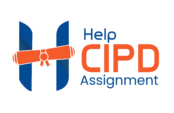Table of Contents
Question: Analyse current developments impacting business environments and their significance for organisational resourcing and talent strategy and practice.
Topic: Identifying current developments in the business environment.
Guideline:
Learners should begin by identifying and analysing current developments such as advancements in the business world, changes in the market, ethical considerations, different initiatives and changes. They should explain how these developments impact an organisation’s resources, strategic capabilities, and practices, with a focus on strategic implementation. Learners should discuss how technological advances can lead to changes in recruiting organisations.
Example:
They can provide specific examples whereby regulatory changes can affect an intellectual property rights.
Evidence:
Learners must provide evidence from reliable sources such as:
CIPD, (2023) Talent management. Available from https://www.cipd.org/en/topics/talent-management/
Kareem, M. A. (2019). The impact of human resource development on organizational effectiveness: An empirical study. Management dynamics in the knowledge economy, 7(1), 29-50.
Question: Evaluate the value of resourcing and talent management strategies.
Topic: Assessing the Value of Talent Management.
Guideline:
Learners must begin by assessing the importance of security and human resources management to the success of an organisation. They should compare internal marketing versus external marketing, talent analysis and development, retention strategies, and the benefits of a “fast track” approach.
Example:
Learners can share an instance where an organisation worked extensively with internal labour market. They can explain how talent development strategies have contributed to improved performance or employee retention.
Sources of Evidence:
Learners should include talent development plans, retention data, and case studies illustrating the advantages of specific strategies. They must also reference reliable sources such as:
Whysall, Z., Owtram, M., & Brittain, S. (2019). The new talent management challenges of Industry 4.0. Journal of management development, 38(2), 118-129.
Quilliam, G. (2023) Talent management. Available from https://www.cipd.org/en/knowledge/factsheets/talent-factsheet/
Question: Critically discuss potential future developments in the fields of resourcing and talent management.
Topic: Discussing Future Developments in Talent Management.
Guideline:
Learners must engage in debates surrounding future developments like flexible staffing practices, technological advancements, and addressing skills shortages and surpluses. They should provide forward-looking insights and their implications.
Examples:
Learners can discuss how an organisation prepares for emerging staffing practices or technological advancements. They can share strategies to cope with potential skills shortages in the future.
Sources of Evidence:
Learners should include strategic plans, forward-looking reports, or initiatives showcasing organisation’s readiness for future developments. They must cite reliable sources such as:
Gallardo-Gallardo, E., & Collings, D. G. (2021). Talent management for the future of work. In New directions in the future of work (pp. 35-54). Emerald Publishing Limited.
Taylor, S. (2021). Resourcing and Talent Management: The theory and practice of recruiting and developing a workforce. Kogan Page Publishers.
Question: Compare ways in which organisations build and maintain a positive reputation in key labour markets by offering compelling employee value propositions.
Topic: Building and Maintaining a Positive Reputation in Labor Markets.
Guideline:
Learners should:
- Compare the strategies employed by organisations to become recognised as employers of choice through compelling employee value propositions.
- Highlight the role of employer branding, diversity initiatives, and ethical working practices.
Examples:
Learners can share examples of how an organisation has built a positive reputation through employer branding or diversity and inclusion programs. They can describe instances where ethical working practices have enhanced an organisation’s image.
Sources of Evidence:
Learners should use reliable sources to reference their work, which may include: Peters, R. (2022) Employer brand. Available from https://www.cipd.org/en/knowledge/factsheets/recruitment-brand-factsheet/
Ali, L. (2022) Equality, diversity and inclusion (EDI) in the workplace. Available from https://www.cipd.org/en/knowledge/factsheets/diversity-factsheet/
Question: Research current developments in job analysis, job design and competency frameworks.
Topic: Investigating Developments in Job Analysis and Design
Guideline:
Learners should:
- Research recent developments in job analysis, job design, and competency frameworks within an organisation or industry.
- Discuss how these improvements enhances an organisation’s goals and business performance.
Example:
Learners can explain how to change the performance model to change the job. They can give specific examples of where this development has led to better competition between candidates and projects.
Evidence:
Learners can share information about new job descriptions, technical skills, and research reports on the impact of these developments. They can cite reliable sources such as:
Pius, A., Alharahsheh, H. H., & Sanyang, S. (2020). Trends and issues in strategic human resources management. In Trends and issues in international planning for businesses (pp. 17-41). IGI Global.
Armstrong, M., & Taylor, S. (2023). Armstrong’s Handbook of Human Resource Management Practice: A Guide to the Theory and Practice of People Management. Kogan Page Publishers.
Question: Evaluate effective recruitment, selection and induction methods in organisations.
Topic: Recruitment Assessment and Selection
Guidelines:
To be able to successfully answer this question, learners must discuss the recruitment assessment and Selection, including the internet, social media, reporting, informal procedures and various tests. They must also evaluate the start-up’s strategy to ensure new employees perform well.
Example:
They can discuss whether an organisation uses social media or informal methods for recruiting and provide examples of successful hiring. They can also explain the selection process and share experiences with the hiring process and its results.
Evidence:
Learner can give evidences of case studies and new employee feedback on the recruitment process. They can reference reliable sources such as:
McCartney, C. (2022) Recruitment: an introduction. Available from https://www.cipd.org/en/knowledge/factsheets/recruitment-factsheet/
Taylor, S. (2021). Resourcing and Talent Management: The theory and practice of recruiting and developing a workforce. Kogan Page Publishers.
Question: Analyse the use of technologies to improve: • attraction • selection • induction.
Topic: Harnessing Technology for Talent Attraction, Selection, and Induction.
Guidelines:
Learners must discuss how to use technology to attract, select and train talent through discussion, negotiation and its role in employee selection. Also, they should discuss how effective technology is in terms of promotion and socialisation for new employees.
Example:
Learners can describe how organisations uses technology, including the impact of chatbots or virtual reality, to attract, select and engage. They can share specific instances and their impact on talent management.
Sources of Evidence:
Learners can include reports or data on technology adoption in an organisation’s recruitment, selection, and induction processes, as well as feedback from new hires on their experiences. They must cite reliable sources, which include:
CIPD, (2023) Technology use in recruitment and workforce planning. Available from https://www.cipd.org/en/knowledge/guides/technology-recruitment-workforce-planning/
Turner, P. (2022). Complementarity in Organizations: Strategy, Leadership, Management, Talent and Engagement in the Fourth Industrial Revolution. Springer Nature.
Question: Evaluate long- and short-term talent planning approaches to meet organisational demand.
Topic: Assessing Long- and Short-Term Talent Planning
Guideline:
To be able to successfully answer this question, learners must:
- Evaluate the major stages of workforce planning and discuss the relevance of workforce planning in your organizatio.
- Consider talent reservoirs, pipelines, and tools of succession planning and their effectiveness.
Examples:
Learners can describe how an organisation has used talent planning strategies to meet long-term and short-term needs. They can share instances where these strategies have resulted in a skilled and agile workforce.
Sources of Evidence:
Learners can include workforce planning documents, talent development programs, and data illustrating the effectiveness of succession planning. They must reference reliable sources such as;
Gallardo-Gallardo, E., & Collings, D. G. (2021). Talent management for the future of work. In New directions in the future of work (pp. 35-54). Emerald Publishing Limited.
Skuza, A., & Scullion, H. (2021). Talent Management in European Organizations. In The Routledge Companion to Talent Management (pp. 176-186). Routledge.
Question: Analyse a range of analytics to determine talent planning and retention strategies.
Topic: Analysing Talent Analytics for Planning and Retention
Guideline:
Learners must:
- Examine data related to employee turnover, wastage rate, average tenure, career progression, and demographic factors.
- Discuss how this information informs talent planning and retention strategies.
Examples:
Learners can provide instances where an organisation has used analytics to inform talent planning and retention decisions. They can explain how these analytics have led to improved workforce stability and growth.
Sources of Evidence:
Learners can share reports on turnover rates, employee demographics, and how data-driven decisions have positively impacted talent planning and retention. They must cite reliable sources that may include:
Peters, R. (2023) Employee turnover and retention. Available from https://www.cipd.org/en/knowledge/factsheets/turnover-retention-factsheet/
Nocker, M., & Sena, V. (2019). Big data and human resources management: The rise of talent analytics. Social Sciences, 8(10), 273.
Question: Justify measures designed to reduce voluntary employee turnover.
Topic: Justifying Measures for Reducing Employee Turnover
Guideline:
Learners should:
- Discuss interventions aimed at reducing voluntary turnover, such as pay, promotion, developmental opportunities, and work-life balance.
- Explain how leadership is effective in retaining talent.
Example:
Learners can show specific insurance policies used in an organisation, such as salary increases or working life programs. Show cases where these measures were successful in reducing income.
Evidence:
Learners can include data collection, employee feedback, and before-and-after statistics to support the effectiveness of retention measures. They must cite reliable sources such as:
Cotton, C. (2023) Pay structures and pay progression. Available from https://www.cipd.org/en/knowledge/factsheets/pay-structures-factsheet/
Turner, P., & Turner, P. (2020). Employee engagement and the employee experience. Employee Engagement in Contemporary Organizations: Maintaining High Productivity and Sustained Competitiveness, 1-26.
Question: Discuss the strengths and weaknesses of different approaches to manage and enhance employee performance.
Topic: Identify ways to improve employee performance
Guideline:
Learners should compare sanctions and cooperation to management jobs. They should also explain their advantages and disadvantages and explain how they can use these lessons in an organisation. Learners should give illustrations of when sanctions or cooperation should be used to control the work of employees in an organisation. They should describe the results and feedback from employees involved in this process.
Example:
Learners can give examples of how performance management works differently, including records, employee feedback and research reports on the impact of management practices.
Evidence:
Learners must provide evidence from reliable sources such as:
TAYLOR, S., & CIACHIR, C. (2022). Improving organisational performance. Human Resource Management: People and Organisations, 145.
Gifford, J. (2022) Performance management: an introduction. Available from https://www.cipd.org/en/knowledge/factsheets/performance-factsheet/
Question: Evaluate the use of technology to monitor individual and team performance.
Topic: Performance monitoring tools
Guidelines:
Learners should:
- Consider new trends in performance monitoring such as video surveillance, data generation, and customer feedback.
- Discuss the ethical implications of technology for people professionals.
- Describe how your organisation uses technology, including ethical considerations, to monitor individual and group work.
- Give specific examples and their business implications.
Example:
Learners should give examples that includes information regarding the use of technology in performance monitoring and any application or compliance information related to the use of the technology. They can give examples such as an organisation having implemented a performance monitoring system such as video surveillance that relies on advanced technology to assess the productivity and effectiveness of both individual employees and teams.
Evidence:
Learners must include references from reliable source such as:
Mohdzaini, H. (2020) Employee monitoring: What’s acceptable? Available from https://www.cipd.org/en/views-and-insights/thought-leadership/the-world-of-work/employee-monitoring/
Green, M. (2022) Ethical practice and the role of people professionals. Available from https://www.cipd.org/en/knowledge/factsheets/ethics-role-hr-factsheet/
Question: Discuss management strategies for attendance and underperforming staff in organisations.
Topic: Strategies for Attendance Management and Addressing Underperformance
Guidelines:
Learners should:
- Discuss strategies for managing attendance and addressing poor performance.
- Discuss different strategies for managing attendance and addressing poor staff.
- Demonstrate ethical, legal and effective practices in an organisation.
Examples:
Learners should share examples of how an organisation manages inclusion and deals ethically and legally with working poor. They should provide case studies or scenarios.
Evidence:
Learners can include employee feedback on engagement policies, information and performance improvement plans, and management strategies. They must reference reliable sources which may include:
Suff, R. (2023) Absence measurement and management. Available from https://www.cipd.org/en/knowledge/factsheets/absence-factsheet/
CIPD, (2019) Ethics at work: An employer’s guide. Available from https://www.cipd.org/en/knowledge/guides/ethics-work-guide/
Question: Critically discuss the legal, ethical and professional lens in relation to retirement, redundancy and dismissal practices.
Topic: Legal Analysis, Equality, Labour Transfers
Guidelines:
Learners should analyse the how to bridge the gap between legal procedures and ethical decisions, such as the understanding of retirement, redundancy and dismissal procedures. They should discuss professional standards throughout this process. Learners should discuss redundant and intermittent, including information regarding legal compliance, fair decision-making and adherence to professional standards in retirement.
Example:
Learners should explain how organisations complies with the law and ethics regarding retirement, redundancy and terminations. They can share case studies or situations that demonstrate compliance with these principles.
Evidence:
Learners must include reliable sources of evidence to support their findings. These references may include:
Suff, R. (2022) Redundancy: an introduction. Available from https://www.cipd.org/uk/knowledge/factsheets/redundancy-factsheet/
Suff, R. (2022) Dismissal procedures. Available from https://www.cipd.org/uk/knowledge/factsheets/dismissal-factsheet/



